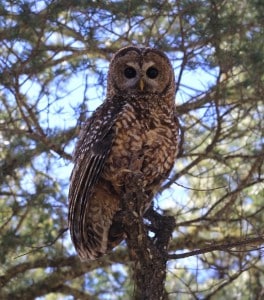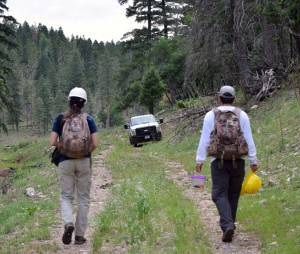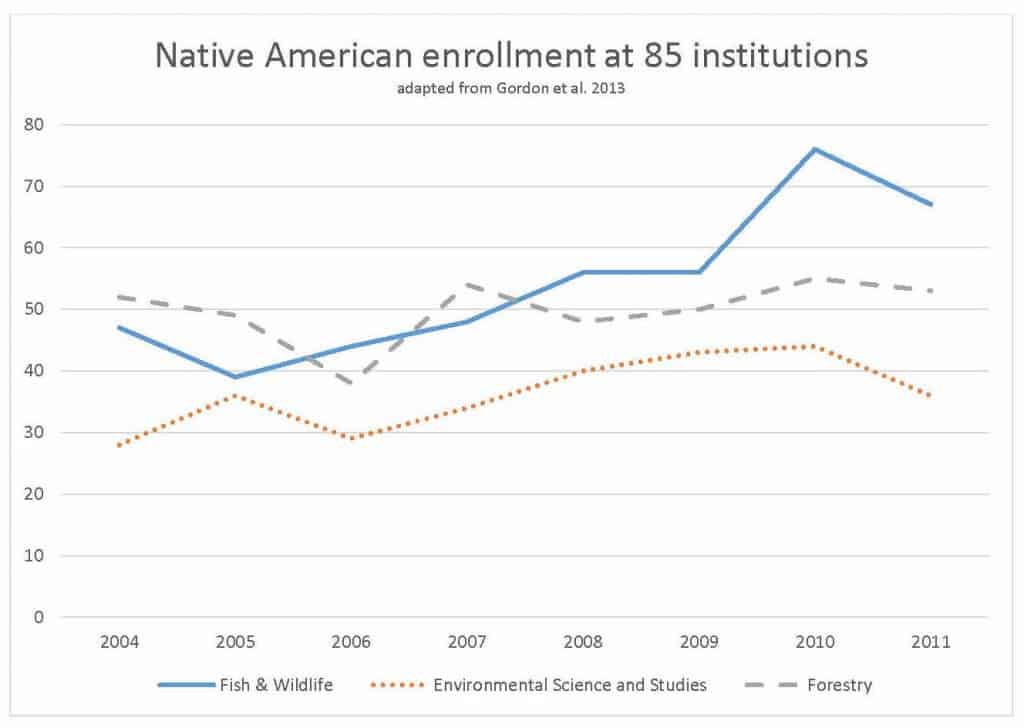Share this article
A Tribal Model of Wildlife Stewardship — from The Wildlife Professional
Native Americans Tap Into Traditional Practices to manage Forests
On a Native American reservation just outside Albuquerque, N.M., Laguna Pueblo tribal members gather for a traditional dance. It’s after fall hunting season, and they’re there to honor the spirit of a harvested mule deer or D yene — as referred to in the tribe’s Keres dialect. The deer serves as the “divine” centerpiece of all ceremonial dances and villages on this roughly 500,000-acre reservation.
For these tribal members, there exists an interdependent relationship between people and deer. One does not exist without the other. In fact, as part of the ceremonial dance, the tribe offers a reciprocal gift to the spirit of the harvested deer in hopes it will return the following year.
Native Americans believe in equally respecting all species without compromising human interactions and sustenance needs — a philosophy that’s carried over into the holistic and integrated management of wildlife and forests. Interestingly, several of these practices are similar to multispecies management concepts and ecosystem management theories that most resource professionals know well. For instance, tribes consider the 7th generation when designing environmental management actions — which isn’t unlike the goal of ecosystem management: to “manage over periods of time long enough to maintain the evolutionary potential of species and ecosystems” (Grumbine 1994).
Tribes also consider all aspects of the environment; and managing natural resources on tribal lands by integrating cultural, economic and ecological values serves as a model to address pressing ecological challenges. As Pat Pierre, tribal elder of the Salish- Pend d’Oreille once stated, it all starts with open communication, respect, friendliness and education (Mason et al. 2012).
Tapping Into An Age-Old Wisdom
There are 567 distinct sovereign Native American Nations throughout the United States. The highest density of tribal lands by region is within the Southwest, making the 2017 plenary theme, “Wildlife
Conservation: Crossroads of Cultures,” of the TWS Annual Conference to be held in Albuquerque that much more significant. In total, Native American tribes manage 56.2 million acres of land — arguably some of the country’s most unpopulated and undeveloped areas. Despite the socioeconomic challenges and other hardships that many tribes face (Tiller 2005; Harvard Project 2008), these lands are rich in natural and cultural resources.
This richness is often evident in satellite images and aerial photography where boundaries of Indian reservations stand out partially due to unique management practices (Grossman 2000). For instance, when it comes to managing forests, the Menominee tribe of Wisconsin relies on advice dating back more than 150 years when Menominee Chief Oshkosh stated, “Start with the rising sun and work toward the setting sun; but take only the mature trees, the sick trees and the trees that have fallen. When you reach the end of the reservation, turn and cut from the setting sun to the rising sun, and the trees will last forever” (Trosper 2007). Here, community trumps individualism and long-term stewardship prevails over short-term financial gains. Although the Menominee have harvested roughly two and a half times the volume of the entire forest over the last 160 years, today, there is more volume and higher quality timber than when the reservation was first established (M. Pecore, Menominee tribal forest field visit 2013).

©Serra Hoagland
Sustainability plays a critical role for tribes managing wildlife and their habitat. Often, tribal natural resource departments are forced to balance the triple bottom line of sustainability that includes equal emphasis on ecological, economic and social values. For instance, a tribe may rely on wildlife to create job opportunities where no other jobs exist, such as hunting and trapping guides, wildlife managers or even tour guides. At the same time, the animals are managed to sustain a stable or growing population and hunted to provide subsistence and cultural education.
The Mescalero Apache tribe of south-central New Mexico is dealing with this very challenge. Tribal members manage 460,000 acres of forested lands with only 10 full-time natural resource staff. Limited staff and funding plague tribal natural resource management, and on average, the federal-to-tribal funding ratio for natural resources on a per-acre basis is 3:1 (Gordon et al. 2013). The Mescalero Apache tribe works closely with the Bureau of Indian Affairs Mescalero Agency foresters and wildlife professionals to ensure its members are employed as part of fire and logging crews, while simultaneously working to protect habitat for the Mexican spotted owl (Strix occidentalis lucida) as well as balancing the fire and fuels risk of the region’s dry mixed conifer forests.
There are cultural complexities that are also at play. Owls carry a negative connotation for the Apache and some other tribes who associate them with sickness or imminent death (Marcot 2007) and, as a result, hesitate to be near the birds. At the same time, the Apache understand the significance of Mexican spotted owls and the species’ contribution to the ecosystem and so, continue to maintain their habitat and local population. Interestingly, recent analysis indicated a significant difference in the composition of managed spotted owl habitat on tribal lands compared to habitat on adjacent U.S. Forest Service (USFS) lands that can be identified with novel remote sensing and satellite imagery techniques (Hoagland 2016).
Collaborating to Address Challenges

Author Serra Hoagland, a member of the Pueblo of Laguna, and Chase Voirin, a member of the Navajo tribe, return from a survey of Mexican spotted owls (inset) on the Mescalero Apache Indian Reservation.
©Elisha Flores
Tribes are often faced with unique challenges when it comes to managing wildlife populations and natural resources — largely a result of limited jurisdiction and checkerboard land ownership, tribal government structure and sovereignty, tribal laws and policies, and overall environmental stressors. Understanding these unique differences, federal agencies such as the U.S. Forest Service engage directly with tribes in multiple ways such as by consulting and listening to tribal research needs, communicating management tools that are available to tribes, providing direct services to tribal natural resource departments, engaging with tribal partners on joint research projects, providing tribal natural resource student research scholarships, and providing employment opportunities for tribal members.
In 2000, then-president Bill Clinton signed an Executive Order — Consultation and Coordination with Indian Tribal Governments (EO 13175, 2000) — that called for federal agencies to consult with tribes when developing policies or management actions that impact Native American communities. About a decade later, USFS created the Tribal Engagement Roadmap, which outlines how USFS agency scientists can partner and engage with Native American tribes. Similarly, in 2015, the USFS Research and Development branch produced a document that showcased several examples of USFS scientists partnering with tribal entities to benefit the management of culturally relevant resources. One example included blending traditional ecological knowledge and western science to monitor and restore bear grass (Xerophyllum tenax) collection sites for use by tribal basket weavers in California (Hummel et al. 2015).
Building a Future with More Wildlife Professionals
There are numerous efforts underway to expand the existing wildlife biologist community of Native Americans. In the late 1990s, a group of Native and non-Native wildlife biologists launched The Wildlife Society’s Native Peoples Wildlife Management Working Group, which today, has over 100 members. Since its inception, the group — which doesn’t require individuals to be tribal members — has helped fund 79 Native American students to attend TWS’ annual conference as well as participate in the Society’s Native Student Professional Development program, which provides students with a one-year complementary membership to the Society along with several professional development opportunities.

Click on image to enlarge. Native American student enrollment at 85 institutions, not including tribal colleges, with fisheries and wildlife fields, is slightly higher than forestry and environmental science and studies. ©Adapted from Gordon et al. 2013
In addition, the U.S. Forest Service partnered with TWS to offer research assistantships to Native American students. Similarly, the Native American Fish and Wildlife Society — a nonprofit organization formed in 1982 — is dedicated to “assist Native American and Alaska Native tribes with the conservation, protection, and enhancement of their fish, wildlife, habitat, and cultural resources.” Although the organization’s southwestern region has approximately 32 Native American wildlife professionals, an accurate count of Native American wildlife professionals nationwide is lacking (NAFWS Executive Board pers. communication).
These nationwide efforts appear to be paying off. The number of Native Americans in wildlife-related fields — specifically in forestry — has doubled since 1993. Further, between 2004 and 2011 there has been a 19 percent increase in Native American enrollment at mainstream colleges and universities in natural resource fields (FAEIS 2013), with the fish and wildlife fields well-represented.
For many, working as a wildlife biologist on a Native American reservation proves to be an extremely rewarding career, whether it involves raising awareness of the community, connecting or reconnecting people to wildlife, or improving habitat for native species. To that end, I would like to recognize and thank the Mescalero Apache and Laguna Pueblo people for their continued support and guidance.
Chief Seattle of the Suquamish people, once stated that “the people belong to the land; the land does not belong to the people.” As wildlife professionals we should continue to engage with the sovereign Native American Nations of this country and the people who are as integral to the ecosystems as the ecological processes themselves that many care about so deeply.
Poem:
Deer Dance/For Your Return
If this
will hasten your return
then I will hold myself above you all night
blowing softly
down-feathered clouds
that drift above the spruce
and hide your eyes
as you are born back
to the mountain.
Years ago
through the yellow oak leaves
antlers polished like stones
in the canyon stream-crossing
Morning turned in the sky
when I saw you
and I wanted the gift
you carry on moon-color shoulders
so big
the size of you
holds the long winter.
– Leslie Marmon Silko Feb 1977 Columbia:
A Journal of Literature and Art No. 1 pp 9-11.
 |
Serra J. Hoagland, Laguna Pueblo, PhD, is a biological scientist with the U.S. Forest Service, chair-elect and native student professional development program coordinator for The Wildlife Society’s Native Peoples Wildlife Management Working Group and a member of The Wildlife Professional’s Editorial Advisory Board. |
Header Image: The Pueblo of Laguna, located 45 miles west of Albuquerque, covers 530,000 acres. The reservation is home to roughly half of the 8,700 tribal members; the other half live off the reservation. Species such as mule deer, bears, Mexican spotted owls, southwestern willow flycatchers, as well as introduced species including Rocky Mountain elk, Himalayan tahr and Barbary sheep, are also found on the reservation. ©Serra Hoagland








